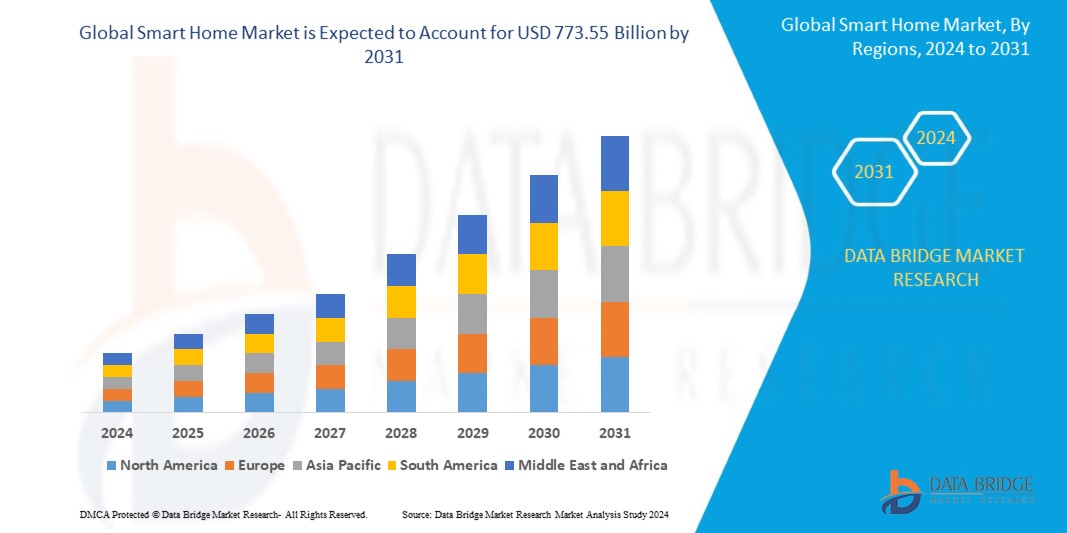Introduction
The smart home market is rapidly transforming how people interact with their living spaces, enhancing convenience, security, energy efficiency, and entertainment. A smart home is equipped with devices connected to the internet, enabling residents to control various systems such as lighting, climate, appliances, and security remotely or through voice commands. These innovations make everyday life easier and more efficient, aligning with the growing consumer demand for automation and intelligent solutions. This article explores the evolution of smart homes, the trends driving their adoption, and a detailed analysis of the market scope, size, and country-level insights.
The Evolution of the Smart Home Market
The concept of the smart home began in the late 20th century with the introduction of basic home automation systems. Early devices, such as programmable thermostats and lighting controls, laid the groundwork for more complex systems. However, it wasn’t until the rise of the internet and wireless technology in the early 2000s that the smart home market started to gain momentum.
As technology evolved, smart home devices became more sophisticated, integrating advanced features like artificial intelligence (AI), machine learning, and cloud computing. These technologies enabled smart home systems to become more intuitive, learning user preferences and automating tasks without direct input. The introduction of voice assistants like Amazon’s Alexa, Google Assistant, and Apple’s Siri further accelerated the adoption of smart home technologies, making it easier for users to control their devices with simple voice commands.
By the 2010s, smart home technology expanded into multiple categories, including smart lighting, smart thermostats, smart security cameras, and home entertainment systems. The rise of the Internet of Things (IoT) has also played a crucial role in the development of interconnected smart devices, enabling seamless communication between different systems within the home.
Market Trends and Factors Driving Growth
Several key trends and factors are contributing to the rapid growth of the smart home market.
One of the primary trends is the increasing demand for energy efficiency. As global concerns about climate change and rising energy costs intensify, consumers are seeking ways to reduce their carbon footprint and save on utility bills. Smart thermostats, lighting systems, and energy monitoring devices help users optimize their energy consumption, making their homes more sustainable and cost-effective. These systems automatically adjust settings based on user behavior, weather conditions, and occupancy, ensuring that energy is used efficiently.
Another important trend is the rise of home security systems. Consumers are increasingly prioritizing safety and security, driving demand for smart cameras, motion detectors, doorbell cameras, and smart locks. These systems offer real-time monitoring and alerts, allowing homeowners to keep an eye on their property from anywhere in the world using smartphones or other connected devices.
Voice control and automation are also significant drivers of market growth. The integration of voice assistants like Alexa and Google Assistant into smart home devices has made it easier for consumers to interact with their homes. From adjusting the thermostat to turning off lights or playing music, voice control offers a hands-free, intuitive way to manage smart home systems. Automation features, which allow devices to work in sync without user intervention, further enhance the convenience of smart homes.
Growing awareness of health and wellness is another key factor influencing the smart home market. As people become more health-conscious, smart home devices that monitor air quality, humidity, and lighting conditions are gaining popularity. These systems help create a healthier living environment by maintaining optimal indoor conditions. Smart kitchen appliances that offer healthier cooking options, such as air fryers and connected ovens, are also contributing to the growth of the market.
Market Scope and Market Size
The smart home market covers a wide range of connected devices and systems, including home automation, energy management, security, and entertainment. It encompasses both standalone devices and integrated ecosystems that allow users to control multiple systems through a single platform or app.
As of 2023, the global smart home market was valued at approximately USD 85 billion and is expected to grow at a compound annual growth rate (CAGR) of 25% from 2023 to 2030. This rapid growth is driven by the increasing penetration of IoT, rising consumer awareness of smart home benefits, and the growing demand for connected devices in developing regions.
The market is segmented by product type, including smart lighting, smart thermostats, smart security systems, smart speakers, smart appliances, and home entertainment systems. Among these, smart security systems hold the largest share of the market, driven by increasing concerns about home safety and the need for remote monitoring capabilities. However, smart speakers and entertainment systems are also experiencing significant growth due to the rising demand for voice-activated controls and immersive entertainment experiences.
In terms of distribution channels, the market is divided into online retail and offline retail. Online platforms are gaining popularity as consumers prefer the convenience of shopping for smart devices online, with access to a wider variety of products and competitive pricing. However, offline retail channels, including electronic stores and home improvement outlets, continue to play a key role in reaching consumers who prefer in-person purchases.
Country-Level Analysis
The smart home market is growing rapidly across the globe, with North America, Europe, and Asia-Pacific being the most significant regions driving growth.
North America is the largest market for smart home devices, accounting for a significant portion of global revenue. The U.S. leads the adoption of smart home technology, with high consumer awareness, widespread internet access, and the presence of major technology companies driving the market. The growing demand for energy-efficient solutions and home security systems is also contributing to the region’s dominance. Government initiatives promoting smart cities and energy-efficient buildings further boost market growth in North America.
Europe is another major market for smart homes, particularly in countries like Germany, the UK, and France. The European market is driven by increasing environmental regulations and energy efficiency standards. The growing trend of home automation and the popularity of voice-controlled devices are key factors driving adoption in the region. In addition, the European Union’s commitment to reducing carbon emissions is promoting the use of smart home technologies that help lower energy consumption.
In the Asia-Pacific region, the smart home market is experiencing rapid growth due to rising disposable incomes, increasing urbanization, and growing smartphone penetration. Countries like China, Japan, and South Korea are at the forefront of smart home adoption in the region, with strong government support for smart city initiatives and technology-driven infrastructure development. In China, the market is driven by the increasing popularity of smart appliances and home automation systems among tech-savvy consumers. Japan’s focus on energy efficiency and aging population also presents significant opportunities for the smart home market.
Latin America and the Middle East & Africa are emerging markets for smart homes, although their growth is slower compared to other regions. In these regions, improving internet access, rising awareness of smart home benefits, and increasing urbanization are driving demand. Governments in these regions are also investing in smart city initiatives, which are expected to boost the adoption of smart home technologies.
Conclusion
The smart home market is growing at an unprecedented rate, driven by the increasing demand for energy efficiency, security, convenience, and health-focused solutions. The integration of IoT, voice assistants, and advanced automation features is transforming how consumers interact with their homes, making everyday life more comfortable and efficient. North America, Europe, and Asia-Pacific are leading the charge in smart home adoption, while emerging markets in Latin America and the Middle East & Africa are showing potential for future growth. As technology continues to evolve and consumer preferences shift towards smarter living, the smart home market is expected to expand further in the coming years.
Get More Detail: https://www.databridgemarketresearch.com/reports/global-smart-home-market




